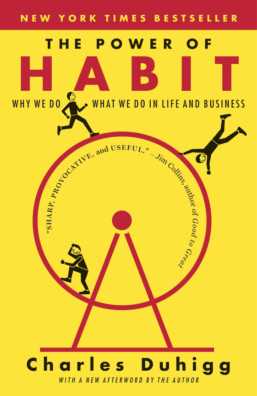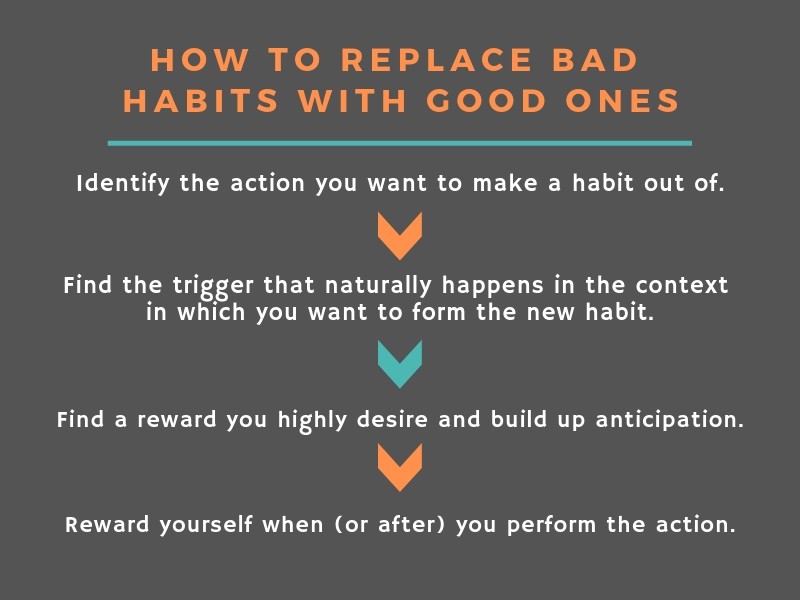Habits can make or break your future and the quality of your life. In fact, your habits are much more defining to your long-term happiness than your IQ, EQ, background, knowledge & skills, or other variables that make up who you are. But how to stop bad habits? This is the question circling the brains of smokers, impulse eaters, nail biters, people who procrastinate, insomniacs, and so on. There is no one-size-fits-all type of recipe for breaking bad habits, but there is always the first step. We hope our guide today will help you take that first step to make sustainable lifestyle choices from now on!
Good and bad, big or small, we all have them. The tough question is, how to stop bad habits and create new, good ones?
The solution, albeit pretty straight-forward, can be a challenge: you need to work for it. Fortunately, this article introduces an easy to follow technique to keep track of your bad habits and replace them with good ones.
Breaking Bad Habits: What You Need to Know
Motivation is what gets you started. Habit is what keeps you going. – Jim Ryun
By definition, a habit is an acquired repetitive behavior that tends to be involuntary.
Before we discuss about how to stop bad habits, first, we need to understand what habits are. As your probably know by now, psychology dedicated years of research and experimentation with habits, behavioral disorders, and addictions. What is more important to address is the following question: where do we draw the line between good, bad, or neutral habits? And is having habits such a terrible thing, after all?
The explanation below is concise, clear, and opens the door for you to further research the subject of habits in psychology:
Habit, in psychology, any regularly repeated behavior that requires little or no thought and is learned rather than innate. A habit—which can be part of any activity, ranging from eating and sleeping to thinking and reacting—is developed through reinforcement and repetition. Reinforcement encourages the repetition of a behavior, or response, each time the stimulus that provoked the behavior recurs. The behavior becomes more automatic with each repetition. Some habits, however, may form on the basis of a single experience, particularly when emotions are involved. Habits, as discussed by William James in his Principles of Psychology, are useful as the means for conserving higher mental processes for more demanding tasks, but they promote behavioral inflexibility.
How to Stop Bad Habits: Identify the Good from the Bad
Bad Habits
Although these might be seen as effective short-term coping mechanisms, bad habits are always unhealthy.
- Smoking
- Stress eating
- Wasting time online
- Being late
- Procrastinating
- Skipping breakfast
- Binge watching
Good Habits
These habits lead to a healthier body and mind and improve the quality of life, sometimes in spite of short-term discomfort.
- Stretching every morning
- Eating (a healthy) breakfast every day
- Putting stuff away right after using them
- Expressing gratitude whenever feeling it
- Walking to work
- Taking the stairs instead of the elevator
Understanding the Psychology of Habits
As we saw in the paragraph above, generally speaking, a habit is formed through a self-reinforcing loop.
You’ve got a trigger that leads to a routine that leads to a certain effect – good or bad. (This book on how habits work by Charles Duhigg provides more info if you’re interested – highly recommend it, very interesting read!)
If you want to learn how to stop bad habits, it is time for some experimentation on our own. Let’s say you have a habit that’s toxic to you, like a vice, a defensive reaction to critique, lashing out when feeling smothered by your significant other, or any other behavior that gets in the way of you getting stuff done and becoming the person you want to be.
If you want to make a change, break down bad habits, and turn them into good ones, you need to identify your trigger, routine, and the effect or reward.
How to Stop Bad Habits: Understand The Routine
The routine is generally the easiest to pinpoint – after all, it’s the action you pursue, even though you might not know why. Smoking a cigarette, craving something sweet, or getting in a certain mood can all be routines of habits if they’re accompanied by a trigger and a reward.
The effect or reward and the trigger, on the other hand, can be a challenge to identify.
How to Stop Bad Habits: Make Sense of The Effect
Figuring out the reward you seek while fighting a bad habit is essential to the whole process because it all boils down to satisfying cravings. If you’re having difficulty in associating a certain craving with your bad habits, it’s time for some experiments. Doing so will help you isolate the real cause.
Every time you feel you’re about to cave in to your bad habit, try to give yourself a different reward. Stay away from screens for a few minutes, eat a snack, interact with a coworker, and the like.
It doesn’t really matter what you choose to do, the important thing is to pick a different action each time.
If you’re still tempted by the habit 15 minutes after replacing the activity with another one, then you did not satisfy the craving and you need to keep trying.
How to Stop Bad Habits: Identify The Trigger
Triggers are essential to our well-being and survival as a species. Being receptive to triggers helped our ancestors satisfy their basic (physiological) needs like finding food, water, or shelter.
In our modern society, however, most of the triggers we respond to on a daily basis focus around secondary needs like our socioeconomic status, personal satisfaction, or love and belonging. We don’t have to hunt every day because we have a paycheck and plenty of stores or restaurants to go to, so our focus naturally shifts towards perfecting our lives. But it rarely truly works like that.
For most of us, the trigger is either: a place, a time, a certain emotional state, a certain person, an audience, an action, or an event. To identify the trigger, simply write down the answers to the following questions every time you notice the behavior or you catch yourself before subduing to it:
- Where are you?
- What time is it?
- How are you feeling?
- Who are you with?
- What are you doing?
- What’s going on around you?
Don’t overthink your answers, but ponder over those you don’t often think about – listening to your gut goes a long way. After several answers, you will be able to pick up a pattern and identify the trigger.
Okay, so now we know how to identify all the gears that make up a habit and how to fight bad ones. Let’s see how to replace a bad habit with a good habit!
Breaking Bad Habits and Replacing Them with Good Ones
There is no influence like the influence of habit. – Gilbert Parker
The easiest way to create a habit is to find a reliable trigger and a reward you crave.
The trigger can be anything that happens around the time when or in the context in which you want to implement a certain behavior. This can mean waking up in the morning, having lunch, having a snack, going into a meeting, or answering a phone call.
The reward MUST be something you deeply crave, something your brain would really look forward to. Eating a bit of chocolate or beef jerky, getting a small gift for yourself, or listening to your favorite band are all great examples.
Here’s the step by step process of breaking bad habits:
- Identify the action you want to make a habit out of.
- Find the trigger that naturally happens in the context in which you want to form the new habit.
- Find a reward you highly desire and build up anticipation.
- Reward yourself when (or after) you perform the action.
Some tips to consider when replacing bad habits with good ones:
- Think about what you’re gaining instead of what you’re giving up. A positive twist is essential. Focus on the long-term benefits of your new habit, which should naturally outweigh the short-term comfort your old habit offers. If you want more positivity in your life, check out our 100+ quotes for positive energy!
- Take it easy & don’t go all in. Let’s say you discovered this method and want to tackle as many bad habits as possible. DON’T. You will overwork your ambition and determination much sooner than you’ll expect, which drastically decreases your chances of success.If you ever worked on a project, you know how to set SMART goals and follow them through until you reach your desired results. Take this breaking bad habits challenge as a project on yourself, with each bad habit as a sub-project you need to finish before you begin the next one on the list.
- Be patient with yourself and practice self-empathy. In fact, I highly recommend this as one of the good habits you adopt. Instead of beating yourself up when relapsing into a bad habit you’re trying to quit, reassess your motivation and/or find a new reward that might work better.
- Prepare for failure. Yes, failure is always an option and you should accept that. When trying to break bad habits, repeatedly trying and failing is more common than you’d think. The most important thing is to persevere, success won’t come right away most of the time. If you need help, check out our motivational and stress quotes to help you power through!
How to Stop Bad Habits: Bottom Line
Chains of habit are too light to be felt until they are too heavy to be broken. – Warren Buffett
Breaking bad habits and replacing them with good ones might take some time and definitely requires effort and dedication.
But it’s also one of the most rewarding actions you can take for the sake of your future self, progress, and living the life you want to.

I’m passionate about personal development and growth, personality traits, and all things related. When I’m not working on myself, I enjoy hiking in the great outdoors, reading, watching movies, and taking care of my indoor garden. But my strongest passion will always be self-help.


